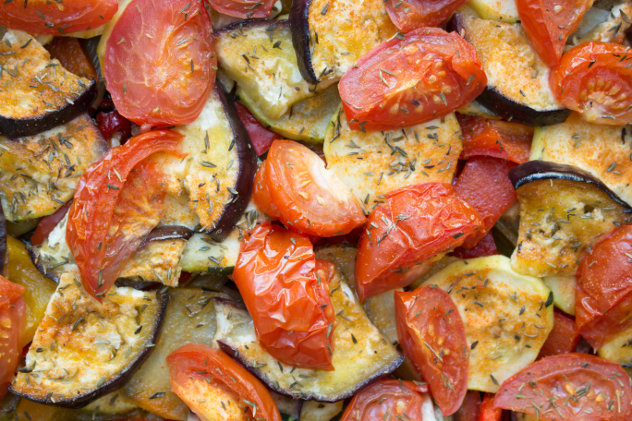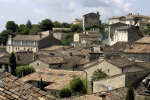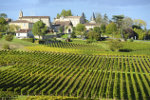The French and their Food: Herbs, Salt, Oil, Soup, Fruit and Vegetables, Meat, Wild and poultry, Fis
Hans van der Kruijf, Friday, 15 September 2017

There is nothing more important than food in France. Any conversation can be kept going by talking about food. Anyone who shares your opinion about preparing food is your friend. Every subject is open to discussion, and every favour can be obtained - after a good meal and a good glass of wine. Who is in France should know something about the food.
Herbs, salt, and oil
Anyone who says herbs says, Provence. A whole range of fresh herbs come from there: Thyme, Laurier, Rozemarine (Romarin). They are indispensable in French cuisine.
Salt is extracted from seawater in three places in France: in the Camarque and at Gruissan in the south (of Les Salins du Midi) and on the Guérande peninsula in Brittany. There is coarse and fine sea salt. A unique sea salt is Fleur du sel. This is the still slightly moist, airy top layer of the dried salt that is removed by hand.
Baking, roasting, and stewing are carried out in butter in the north of France and in the south in olive oil. The olive oil town of France is Nyons in Provence. The best olive oil comes from the first cold pressing (Prime Minister pression à froid). For some olive oils, prices are paid for which you also have a good bottle of wine. A good olive oil is tested by baking a piece of white baguette in it.
Soup
Depending on the thickness, soup is called soupe, potage or consommé (from thick to thin). A soupe de poisson is a fish soup made from ground fish, accompanied by a piece of roasted bread (croutons) in garlic, rouille (paprika/garlic mayonnaise) and grated cheese. How exactly this combination should be eaten is a matter of taste, but it is certainly not the intention to eat all ingredients one by one. A real Bouillabaisse is often mistakenly called fish soup but is a stew of fish, which is cooked for a long time on low heat. Bouillabaisse is usually served as a main meal for 2 or more persons.
Note: A Terrine is not a large pan soup but a slice of meat, fish or vegetable pastry.
Fruit and vegetables
Almost all the fruit and vegetables we know in the Netherlands also exist in France, but French beans (haricots verts) and lettuce (salad vert) are favorite. In the south, paprika (poivron), aubergine, tomato, onion (oignon) and garlic (aile) are the essential ingredients for a Ratatouille.
Potatoes (pomme de terre) are seen as vegetables and sold separately.
The vegetables are often offered on the markets fresh from the country, depending on the season and region. In the supermarkets, the vegetables come from far away all year round.
Fruit is, certainly in the south (the Drôme area, the Languedoc), overripe and for sale at bargain prices along the roadside. Eating up immediately, because a box of overripe peaches does not survive long journeys by car. Normandy is the land of apples. They turn the apples into cider, a lightly alcoholic apple juice, and calvados is fired from the rotting waste. Cider is a good Norman habit of drinking with a crepe, a thin sweet pancake, or its savory counterpart the galette.
Despite the abundant supply of fresh fruit from French soil, most fruit in the supermarkets comes from Spain or Egypt. The French horticulturists occasionally protest against this by pumping fruit loads onto the motorway.
Meat and meat products
Everything that moves in nature is eaten in France, but andouillettes and trips are less suitable for foreign stomachs. Other edible organs are cerveau (brain) and rognons.
Meat is still prepared with bone and fat. So some carving on the board is necessary. An entrecoté looks a bit wild in France. Beef steak (bifteck) is available in various qualities. A loin steak is a rumsteak and the most expensive variant is the tournedos.
The waiter asks for the desired baking of the meat: From bleu, saignant, a-point, to bien-cuit. In case of doubt, bien-cuit is usually the right choice.
A steak háché is chopped steak, served raw with onion and a raw egg on top in restaurants, to mix it yourself - not a favourite with Dutch people, who often confuse it with the simple roast ball of minced meat. The paupiette de veau (calf minced) or the paupiette de porc (pigs minced) look more like a meatball.
Pigmeat is porc. Sometimes a Pied de Porc is on the menu as a specialty: A pig's foot. The old halls in Paris have a brasserie with this name, which used to serve pig's pig herds from 6 o' clock in the morning.
Sausages are called salaisions (salted) or saucissons. They are drier and harder than we are used to. They are served in thin slices with the drink or with different kinds on a plate as an appetizer at a menu (charcuterie).
Ham (jambon) exists in many thick or thinly cut varieties, and is also whole - so such an entire piece on a string - for sale on the market or at the farmer's (au ferme).
Wild and poultry
No matter how pitiful, but rabbits (lapin), deer (cerf) and Obelix's favorite costume the wild boar (sang windlass) are widely sold in France. The game season is of course in the autumn, when hunting starts in all its intensity. Partridge, poultry (pintade) and quails (caille) are often grown and released to be shot.
Duck (canard) is a relatively common dish in France. The magret de canard is the duck breast, baked or grilled. A cuisse the canard is a duck leg, which is preserved in fat. A caneton is a young duckling, so don't expect a big piece of meat on the board! The goose (oie) mainly supplies the liver (foie) but can also be eaten as an animal. A chicken is a poule, but in France, you also eat cocks (coq) and hens (poularde). Turkey is dinde. The huge Christmas turkey is called chapon. The pigeon we know from the street can be found here on the menu as a pignon.
Fish
There are fish from the Mediterranean such as tuna (thon), anchovy (anchois) and sardines, and Atlantic (sole sole, turbot, turbot). Fresh trout (true) and pike-perch (Sandre) come from the fast flowing rivers in the mountains. Of course, the fish is farthest where you are closest: -)
Shells
Those who love shells can indulge themselves. Under the name fruit de mer, a large plateau is served with lobster (homard), crab, mussels (moules) and other shell species (coquillages).
Oysters (huitres) are a beloved delicacy in France. It owes its French name to the cardinal Richelieu's decree that oysters in Paris could only be eaten during the 8 (huit) months that the R was in the month. Dead oysters frequently caused food poisoning, resulting in death, among the chic nobility around the courtyard. The oysters were transported from the Mediterranean and Atlantic coasts by horse and cart, packed in ice. In the hot summer months, that was not enough.
The real lover eats the oyster raw, live and fresh, with a glass of cold white wine. Every processing of the oyster is a horror for the refined aftertaste.

There is nothing more important than food in France. Any conversation can be kept going by talking about food. Anyone who shares your opinion about preparing food is your friend. Every subject is open to discussion, and every favour can be obtained - after a good meal and a good glass of wine. Who is in France should know something about the food.
Herbs, salt, and oil
Anyone who says herbs says, Provence. A whole range of fresh herbs come from there: Thyme, Laurier, Rozemarine (Romarin). They are indispensable in French cuisine.
Salt is extracted from seawater in three places in France: in the Camarque and at Gruissan in the south (of Les Salins du Midi) and on the Guérande peninsula in Brittany. There is coarse and fine sea salt. A unique sea salt is Fleur du sel. This is the still slightly moist, airy top layer of the dried salt that is removed by hand.
Baking, roasting, and stewing are carried out in butter in the north of France and in the south in olive oil. The olive oil town of France is Nyons in Provence. The best olive oil comes from the first cold pressing (Prime Minister pression à froid). For some olive oils, prices are paid for which you also have a good bottle of wine. A good olive oil is tested by baking a piece of white baguette in it.
Soup
Depending on the thickness, soup is called soupe, potage or consommé (from thick to thin). A soupe de poisson is a fish soup made from ground fish, accompanied by a piece of roasted bread (croutons) in garlic, rouille (paprika/garlic mayonnaise) and grated cheese. How exactly this combination should be eaten is a matter of taste, but it is certainly not the intention to eat all ingredients one by one. A real Bouillabaisse is often mistakenly called fish soup but is a stew of fish, which is cooked for a long time on low heat. Bouillabaisse is usually served as a main meal for 2 or more persons.
Note: A Terrine is not a large pan soup but a slice of meat, fish or vegetable pastry.
Fruit and vegetables
Almost all the fruit and vegetables we know in the Netherlands also exist in France, but French beans (haricots verts) and lettuce (salad vert) are favorite. In the south, paprika (poivron), aubergine, tomato, onion (oignon) and garlic (aile) are the essential ingredients for a Ratatouille.
Potatoes (pomme de terre) are seen as vegetables and sold separately.
The vegetables are often offered on the markets fresh from the country, depending on the season and region. In the supermarkets, the vegetables come from far away all year round.
Fruit is, certainly in the south (the Drôme area, the Languedoc), overripe and for sale at bargain prices along the roadside. Eating up immediately, because a box of overripe peaches does not survive long journeys by car. Normandy is the land of apples. They turn the apples into cider, a lightly alcoholic apple juice, and calvados is fired from the rotting waste. Cider is a good Norman habit of drinking with a crepe, a thin sweet pancake, or its savory counterpart the galette.
Despite the abundant supply of fresh fruit from French soil, most fruit in the supermarkets comes from Spain or Egypt. The French horticulturists occasionally protest against this by pumping fruit loads onto the motorway.
Meat and meat products
Everything that moves in nature is eaten in France, but andouillettes and trips are less suitable for foreign stomachs. Other edible organs are cerveau (brain) and rognons.
Meat is still prepared with bone and fat. So some carving on the board is necessary. An entrecoté looks a bit wild in France. Beef steak (bifteck) is available in various qualities. A loin steak is a rumsteak and the most expensive variant is the tournedos.
The waiter asks for the desired baking of the meat: From bleu, saignant, a-point, to bien-cuit. In case of doubt, bien-cuit is usually the right choice.
A steak háché is chopped steak, served raw with onion and a raw egg on top in restaurants, to mix it yourself - not a favourite with Dutch people, who often confuse it with the simple roast ball of minced meat. The paupiette de veau (calf minced) or the paupiette de porc (pigs minced) look more like a meatball.
Pigmeat is porc. Sometimes a Pied de Porc is on the menu as a specialty: A pig's foot. The old halls in Paris have a brasserie with this name, which used to serve pig's pig herds from 6 o' clock in the morning.
Sausages are called salaisions (salted) or saucissons. They are drier and harder than we are used to. They are served in thin slices with the drink or with different kinds on a plate as an appetizer at a menu (charcuterie).
Ham (jambon) exists in many thick or thinly cut varieties, and is also whole - so such an entire piece on a string - for sale on the market or at the farmer's (au ferme).
Wild and poultry
No matter how pitiful, but rabbits (lapin), deer (cerf) and Obelix's favorite costume the wild boar (sang windlass) are widely sold in France. The game season is of course in the autumn, when hunting starts in all its intensity. Partridge, poultry (pintade) and quails (caille) are often grown and released to be shot.
Duck (canard) is a relatively common dish in France. The magret de canard is the duck breast, baked or grilled. A cuisse the canard is a duck leg, which is preserved in fat. A caneton is a young duckling, so don't expect a big piece of meat on the board! The goose (oie) mainly supplies the liver (foie) but can also be eaten as an animal. A chicken is a poule, but in France, you also eat cocks (coq) and hens (poularde). Turkey is dinde. The huge Christmas turkey is called chapon. The pigeon we know from the street can be found here on the menu as a pignon.
Fish
There are fish from the Mediterranean such as tuna (thon), anchovy (anchois) and sardines, and Atlantic (sole sole, turbot, turbot). Fresh trout (true) and pike-perch (Sandre) come from the fast flowing rivers in the mountains. Of course, the fish is farthest where you are closest: -)
Shells
Those who love shells can indulge themselves. Under the name fruit de mer, a large plateau is served with lobster (homard), crab, mussels (moules) and other shell species (coquillages).
Oysters (huitres) are a beloved delicacy in France. It owes its French name to the cardinal Richelieu's decree that oysters in Paris could only be eaten during the 8 (huit) months that the R was in the month. Dead oysters frequently caused food poisoning, resulting in death, among the chic nobility around the courtyard. The oysters were transported from the Mediterranean and Atlantic coasts by horse and cart, packed in ice. In the hot summer months, that was not enough.
The real lover eats the oyster raw, live and fresh, with a glass of cold white wine. Every processing of the oyster is a horror for the refined aftertaste.

Search for French property and real estate for sale in all regions of France. Fermettes, gites, houses, B&B’s for sale by owner. Houses for sale in Gironde, Dordogne, Landes, Calvados, Manche and Orne
 Every year we ask the readers of France Property Guides about their dreams and plans for buying a property in France. The 2020 survey took place in the
midst of the coronavirus pandemic, but the huge response is a clear sign that we’re raring to go as soon as we can.
Every year we ask the readers of France Property Guides about their dreams and plans for buying a property in France. The 2020 survey took place in the
midst of the coronavirus pandemic, but the huge response is a clear sign that we’re raring to go as soon as we can.
More articles